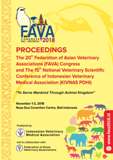VPH-3 Framework to Evaluate Factors Associated With the Roaming Behaviour of Dogs in Flores Island, Indonesia
Abstract
Dogs (Canis familiaris) are among the earliest domesticated animals and one of the most ubiquitous domestic species worldwide. Albeit of many benefits, this partnership can cause problems. Zoonoses (diseases transmittable from animals to humans) transmitted by dogs, particularly rabies, can have a high impact on animal and public health. Worldwide, more than 99% of human cases result from dog bites. The disease is responsible for around 59,000 human deaths per year with 60% occurring in Asia (1)(2). In societies where domestic dogs are owned, but free-roaming, a substantial risk for disease transmission through frequent contacts within the dog population exists. Yet, knowledge on the behaviors of free roaming domestic dogs (FRDD) is limited. Published studies exist on demography of dog populations worldwide, however studies examining roaming behavior and factors influencing it are rare. Do FRDD behave similarly worldwide? Is a dog just a dog? Or are there specific factors that influence their roaming behavior and therefore disease transmission? Such information is needed to inform mathematical disease spread models, which can be used to design evidence-based disease control strategies within FRDD populations.
We hypothesize that the behavior of FRDD depends on individual-dog, anthropogenic and environmental factors, which consequently influence the spread of infectious diseases in dog populations, which is also influenced by the duration of the immunity after anti-rabies vaccination. Our objectives are to identify those influential factors and investigate the impact of identified factors on disease spread.
We combine infectious disease modelling with empirical data collected in Flores Island, West Nusa Tenggara, Indonesia. We identified three study sites (Pogon, Habi, and Hepang) including urban and rural areas of different dog density. We gathered the following data: Movement data from individual dogs and contact rates among them using GPS collars, dog characteristics and management by conducting interviews with dog owners, environmental factors through observation, serological samples through venipuncture, and dog counts via transects. We targeted 200 dogs (100, 60 and 40 dogs for high, middle and low-density sites). These are appropriate sample sizes, based on our previous experience. Blood samples are collected over a one year period. All the dogs included in the study are sampled at D0, D30, D90, D180 and D360 after vaccination. The samples will be serologically analyzed for rabies antibodies and compared to the vaccination history of the dogs. We will then incorporate knowledge gained on dog roaming, rabies immunity and dog population size into mathematical agent-based simulation models.
Thanks to this study, and similar data collected in African and Latin American countries, we will have a better understanding of the behaviour of the FRDD worldwide and their impact on zoonosis transmission. This study will contribute to the common aim of WHO and OIE to eradicate dog mediated human rabies by adapting the current recommendations for rabies vaccination to local settings and getting knowledge on the empirical rabies immunity duration in the field. Considering the close linkage between dog and human health, this study will also benefit humans by controlling rabies in free roaming domestic dog populations. Our objectives are to identify those influential factors and investigate the influence of identified factors on disease spread.

